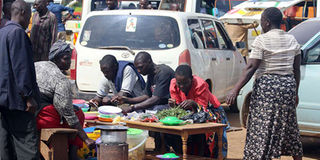Challenges, prospects from operating street food sector

Locals have lunch at an open air food joint in Kisii. Many vendors do not have access to insurance or any form of compensation. PHOTO | FILE | NATION MEDIA GROUP
What you need to know:
- Lack of specific policies and regulations to govern the sector provides room for poor standards of hygiene and safety.
- There is a need to incorporate the street food sector into urban planning for better economic governance.
Street food is a growing informal service sector that provides relatively affordable food and is a major source of income and employment for low-skilled citizens.
It is increasingly important in low-income residential areas, informal settlements, street corners, public offices, bus/train terminals and school compounds.
A large number of working people frequently eat outside as they do not have sufficient resources or time to prepare their food.
Common street food is rich in energy (such as chapati, ugali and mandazi) or has mixed nutrients (such as githeri, mokimo and kienyeji, such as irio).
Other common foods include mutura - Boerewors - fish, chips, roasted maize, fruits and fruit salads. Most of the street food is relatively inexpensive and easily accessible to buyers.
LICENCE
For a long time, urban authorities and police have considered street vending as illegal. Hawkers are often harassed and forced to pay informal penalties or fines. This has discouraged or hindered organised growth of the sector.
The vendors operate without any official recognition or urban policy. They are vulnerable to loss of their merchandise (and equipment) during street riots or similar chaos.
Many do not have access to insurance or any form of compensation. Most vendors do not have specific food preparation and associated business skills other than those gained through observation, learnt from their parents or self-taught (trial and error).
Most vendors work for long (12—15) hours daily, in order to feed and educate their children.
HYGIENE
Many hawkers operate without any monitoring of what food they prepare and how they do it. Some have been jailed for selling meat from illegal sources (such as dogs and donkeys).
Lack of specific policies and regulations to govern the sector provides room for poor standards of hygiene and safety.
A large number of street food vendors operate in areas with high human traffic not allowing sufficient room for the display and sale of their products.
Vending units are open structures such as push carts or wooden tables that are not appropriate for food preservation. Most of the businesses operate without clean running water.
Water is never enough for proper dish washing, food preparation and for customers.
There are potential health risks in the street food sector. The majority of street vendors use non-disposable plates, cups and cutlery. These utensils are not properly cleaned after use by different consumers, which can result in food contamination and disease transmission.
POLICY
Street foods are prepared, sold and consumed in open places exposed to dust, motor vehicle exhaust fumes and flies.
Personal hygiene is not regularly observed, as many hawkers do not cover their heads or wear overalls/aprons.
Many hawking places do not have adequate basic facilities such as toilets, hand-washing facilities and good drainage, which increase the risk of transmission of disease. Some street food vendors reuse perishable food leftovers, which could result in health risks to consumers. Poor storage of food at inappropriate temperatures is another risk to human health.
But street food vendors add colour and vibrancy to urban life. However, the street food industry operates in an informal and unregulated environment.
There is a need to incorporate the street food sector into urban planning for better economic governance.
EXPERIENCE
Therefore, urban policy regimes and legislative approaches should include the role of street food in achieving the food and nutrition needs of the growing urban population.
There is a need for coordinated institutional interventions to balance regulatory and incentive-based approaches in the street food industry. There is a considerable amount of energy and water that is saved by households, which would otherwise be used for cooking and cleaning.
There are reduced risks as fire or explosion of gas cylinders or stoves, which is beneficial to the greater society in terms of cost and trauma.
In many cities around the world, eating indigenous street food is part of the visitor experience.
BRAND
Improving food safety and public hygiene would go a long way in making street food a matter of national pride and brand image (such as nyama choma na kachumbari).
The role of the government and the private sector cannot be over-emphasised.
There is a need for the national and county authorities to institute appropriate and inclusive policies to ensure that street food is safe, hygienic and wholesome for human consumption.
This would include securing the environment for trading, and enforcement of food safety.
Dr Kakonge is the president of the Association of Former International Civil Servants and a former ambassador to the United Nations ([email protected]), while Dr Omiti is a former executive director of the Kenya Institute for Public Policy Research and Analysis ( [email protected]). Mutuma Mathiu’s column resumes next week.




